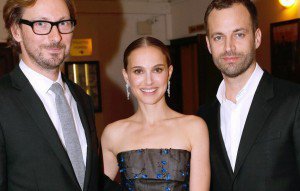Time to show some love for our French speaking visitors. Aurore sent word that there is now a French poster and trailer for Brothers, as well as a website.
But that’s not all, Carlotto found a really great preview of Black Swan that provides a lot more details about the film and looks at it in contrast to his entire filmography.
If French isn’t your mother tongue, fear not, Carlotto has transcribed the entire article. You can read it after the jump.
Darren Aronofsky has had a close shave. Without the recognition of The Wrestler from both the public and the critics, his new film Black Swan could not have originated. Black Swan stars Natalie Portman, Mila Kunis, Winona Ryder, Barbara Hershey and Vincent Cassel. Many talented people for what is to be one of the most important movie of 2010.More than ever, Darren Aronofsky is long-expected. His movies spark off ecstasy from his admirers as well as ire from his detractors. In spite of the controversies, he is still here. Whereas he were announced on different projects (Robocop, The Fighter, canceled after Brad Pitt left it — second missed rendezvous between them), he embarked on Black Swan, surprising everyone. In order to understand this choice, we must get back to The Fountain, an experience so trying for Aronofsky (budget brought down to 20 millions dollars, Brad Pitt and Cate Blanchett leaving the project) that he had to move on a cheaper, more accessible film. This is exactly what happened with Richard Kelly after Southland Tales, who eventually directed The Box as an expiatory commission.
We are in 2007: Aronofsky proposes Black Swan to Universal — the script has already been written by Mark Heyman, his assistant on The Fountain, and is based on an original idea from John McLaughlin. But Universal, dampened by how The Fountain was welcomed, leaves the project on standby. Thus Aronofsky embarked on another project and then a wonder happens with The Wrestler, in which nobody believed (except Wild Bunch) and of which the budget was under 3 millions dollars, If, outwardly, the story is very classical (the redemption of a former wrestler sharing his life between his fights of last-minute, a lost stripper and an addict daughter whom he abandoned), the director distills it by concentrating the dramaturgy to the extreme and shooting the worn out and bruised face of Rourke in contradiction with the frame, the blows, the fury of the public, of the fights. But such sobriety implies sacrifices.
Having limited resources, Darren Aronofsky had to change his usual team (a more unobtusrive soundtrack by Clint Mansell overpowered by Bruce Springsteen track, no more Matthew Libatique as director of photography, no more Eric Watson as producer) and to make his movie less showy, without all these shooting and editing effects. Some took this as a sign of maturity. But whether you like it or not, Aronofsky is still very skillful. The Wrestler actually is a way of starting up again and going on making movies. For him, making movies is a matter of life or death. And you can understand it only by looking his previous films, where every character has to struggle through thick and thin in order to reach a secret goal : to experience an unearthly truth (Pi), to go through addiction for better days (Requiem for a Dream), to finish a novel at the expense of an immortal love (The Fountain), to continue the show in order not to die (The Wrestler). Every time, there is this threat of suppression.
Aronofsky tells the same story in Black Swan as in The Wrestler, but this time in the more female world of ballet dancers — which Robert Altman had already explored a little in Company, with Neve Campbell. Not for the sake of shooting pretty girls’ tiptoe but to crudely reveal what happens behind the scenes, the tricks, the monstrosity. We follow Nina (Natalie Portman) in New York who is the member of a company of ballet dancers in which there is a tough competition. Every one want to take Beth’s place (Winona Ryder) who is leaving and looking for a substitute for the lead role in the ballet “Swan Lake” of which the premiere is to happen in a few days. It is a complicated role since it necessitates some kind of schizophrenia: there is the light side of the angel (The White Swan) and the dark side of the devil (The Black Swan), Yevna (Vincent Cassel), the manager of the company, is well aware of Nina’s talent but cannot perceive in her this duality that could have been appropriate. Another complication for Nina is the rivalry with Lily, an ignorant upstart (Mila Kunis) who always pushes the limits of her performances and provokes from the ballet dancer a sick combination of fascination, jealousy and repulsion. Why does she look like her more and more? Could she be a Doppelgänger? How can she transform herself intellectually and physically when in contact with someone else? What if the traditionnal order was covertly threatened by one of the most evil exterminating angel?
Be warned: Darren Aronofsky describes Black Swan as a psychological thriller, halfway through Rosemary’s Baby by Roman Polanski (1968) and The Red Shoes by Michael Powell (1949). The storyline should take forked and surprising ways, heading toward anguish and irrationality, sometimes in the ambivalent areas of split personality, through this notion of duality never defined as being ontologically evil. Apart from that, the director of photography will be Matthew Libatique and the editor will be Arnaud Weisbum, who already worked on The Wrestler.
With Aronofsky, every framing is important, every look has an impact, every duration has a meaning, every gesture an effect. In Black Swan, we find his taste for subjectivity again: going into the head of a metamorphosing character. In Pi, the camera explored the inner world of the mathematician to such an extent that we felt what he saw, lived or fantasized. If he looked at a leaf or a cup of tea, he could see its molecular structure (and the camera showed it to us). In the end, we knew that he was cured of his obsession because the leaf he was looking at was shot normally. In Requiem For A Dream, Aronofsky embraced four different point of view and used a split screen to impart the scission. In The Fountain, he only needed to switch the sound off to impart a feeling of isolation. In The Wrestler, he followed through sequence shots the wanderings of that lonely wrestler who is entangled in his existential troubles, often filmed from behind.
Black Swan should also be a story about being all alone in the world and taking risks about life and death. Just in case we had not understood that those who is struggling for his life is Darren Aronofsky, none other. What seems obvious is that every one of his movies transcribe his current state: alienating obsession and sexual frustration in Pi, thirst for excesses and fear of a dehumanized coldness in Requiem For A Dream, incurable love in The Fountain, the last fight in The Wrestler. It is now the turn of mortal competition to rage, with the promise of a survivor — that we acclaim or loathe — finally getting back at the Hollywood system. Provided he does not miss the boat — because the uppercut could be fatal.

